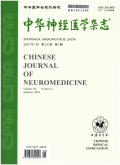双支架后释放技术辅助栓塞治疗颅内破裂椎动脉夹层动脉瘤的疗效
Efficacy of dual stent-assisted coil embolization in ruptured vertebral artery dissecting aneurysms
摘要目的:评估双支架后释放技术辅助弹簧圈栓塞治疗颅内破裂椎动脉夹层动脉瘤(VADAs)的疗效和安全性。方法:选择莆田学院附属医院神经外科自2015年9月至2020年3月采用双支架后释放技术辅助弹簧圈栓塞治疗的17例颅内破裂VADAs患者(17个动脉瘤),术后即刻行DSA检查评估VADAs的栓塞程度,随访结束时采用改良Rankin量表(mRS)评分评估患者的预后,DSA检查判断动脉瘤的愈合情况。结果:术后即刻DSA检查显示完全栓塞6例,次全栓塞8例,部分栓塞3例;2例患者围手术期死亡,2例术后出现颅神经麻痹症状。15例患者术后随访5~24个月,预后良好14例,预后不良1例;11例患者完成DSA随访,其中8例VADAs完全愈合,2例稳定,1例复发。结论:双支架后释放技术辅助弹簧圈栓塞治疗颅内破裂VADAs安全、有效。
更多相关知识
abstractsObjective:To evaluate the safety and efficacy of dual stent-assisted coil embolization in intracranial ruptured vertebral artery dissecting aneurysms (VADAs).Methods:Seventeen patients with intracranial ruptured VADAs (17 aneurysms), treated with dual stent-assisted coil embolization in our hospital from September 2015 to March 2020, were recruited. DSA was performed immediately after surgery to evaluate the embolization degrees of VADAs. At the end of follow-up, modified Rankin scale (mRS) was used to evaluate the prognoses of these patients, and DSA was used to determine the healing status of aneurysms.Results:The postoperative immediate DSA showed that total occlusion was achieved in 6 patients (35.3%), subtotal occlusion in 8 (47.1%) and partial occlusion in 3 (17.6%). Two patients died during the perioperative period and 2 patients presented symptoms of cranial nerve palsy after surgery. Fifteen patients were followed up for 5-24 months, 14 were with good prognosis, and one was with poor prognosis. Eleven patients underwent DSA follow-up, which showed that 8 aneurysms healed completely, 2 aneurysms were stable, and 1 aneurysm recurred.Conclusion:Dual stent-assisted coil embolization may be an effective and safe treatment method for intracranial ruptured VADAs.
More相关知识
- 浏览0
- 被引1
- 下载0


相似文献
- 中文期刊
- 外文期刊
- 学位论文
- 会议论文



 换一批
换一批 换一批
换一批



